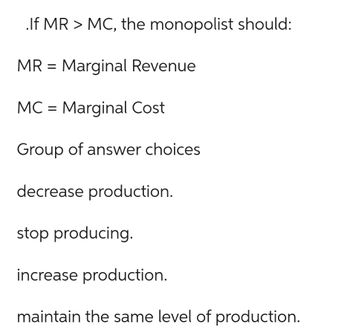
ENGR.ECONOMIC ANALYSIS
14th Edition
ISBN: 9780190931919
Author: NEWNAN
Publisher: Oxford University Press
expand_more
expand_more
format_list_bulleted
Question

Transcribed Image Text:.If MR > MC, the monopolist should:
MR = Marginal Revenue
MC = Marginal Cost
Group of answer choices
decrease production.
stop producing.
increase production.
maintain the same level of production.
Expert Solution
This question has been solved!
Explore an expertly crafted, step-by-step solution for a thorough understanding of key concepts.
Step by stepSolved in 2 steps

Knowledge Booster
Learn more about
Need a deep-dive on the concept behind this application? Look no further. Learn more about this topic, economics and related others by exploring similar questions and additional content below.Similar questions
- The graph below presents the curves associated with the firm JT Minn.. JT Minn. is a monopolist that produces dishwashers. Move the point on the demand curve to represent the price JT Minn. would charge and the quantity at which they would produce. Price/ Cost (570,$20) (980,$33) Marginal I Revenue I Marginal Cost Demand Quantityarrow_forwardWhich one of the following is the best description of a monopolist? a.a firm that is the sole producer of a product for which there are no good substitutes in a market with high barriers to entry b.a firm that is the sole producer of a narrowly defined product class, such as yellow, grade-A butter produced in Wisconsin c.a firm that is large relative to its competitors d.a firm that produces a single productarrow_forwardmonopolist’s profit-maximizing output is 500 units per week and it sells its output at a price of $70 per unit. The firm’s total costs are $15,000 per week. The firm is maximizing its profit, and it earns $40 in extra revenue from the sale of the last unit produced each week. a. What are the firm's weekly economic profits?arrow_forward
- a. At what output rate and price does the monopolist operate? b. In equilibrium, approximately what is the firm’s total cost and total revenue? c. What is the firm’s economic profit or loss in equilibrium?arrow_forwardAnswer the question by referring to the table below. The table shows the demand curve facing a monopolistwho produces at constant marginal cost of 6. In short-run equilibrium, the monopolist will produceQuantity Price10 1020 930 840 750 660 5a) 20 unitsb) 30 unitsc) 40 unitsd) 50 unitsarrow_forwarda. what is the optimal quantity of goods for the firm to produce b. what is the optimal price for the quantity of goods for the firm to produce c. what is the total revenue for the firm d. what is the total cost for the firm e. what is profit/loss for the firmarrow_forward
- Figure monopolist, to answer questions a-c. a. indicate the profit maximizing price and output level and label them P 1 and Q 1. b. Shade in the area that represents the firm's economic profit (or loss). c. If this firm wished to discourage entry by other firms it could produce the output level at which it earns only a zero economic profit. Indicate the price and output level associated with a zero economic profit and label them P 2 and Q 2.arrow_forwardThe graph to the right includes a monopolist's demand, marginal revenue, average total cost, and marginal cost curves. 1.) Use the point drawing tool to Indicate the profit-maximizing level of output and price. Label this point 'Point A' 2.) Use the rectangle drawing tool to shade in economic profitsLabel this shaded area 'Profit'. Carefully follow the instructions above, and only draw the required objects.arrow_forwardWill the monopolist produce an output level that is allocatively efficient?arrow_forward
- No chatgpt answerarrow_forwardIf variable costs decrease, what will a monopolist do? a raise prices and reduce output. b lower prices and expand output. c raise prices and expand output. d lower prices and reduce output.arrow_forwardThe Mamas and the Papas, a monopolist, faces a constant marginal cost of $3 of producing cashews. If it believes the elasticity of demand for cashews is -4, calculate the price it should charge for its product. Write answer explicitlyarrow_forward
arrow_back_ios
SEE MORE QUESTIONS
arrow_forward_ios
Recommended textbooks for you

 Principles of Economics (12th Edition)EconomicsISBN:9780134078779Author:Karl E. Case, Ray C. Fair, Sharon E. OsterPublisher:PEARSON
Principles of Economics (12th Edition)EconomicsISBN:9780134078779Author:Karl E. Case, Ray C. Fair, Sharon E. OsterPublisher:PEARSON Engineering Economy (17th Edition)EconomicsISBN:9780134870069Author:William G. Sullivan, Elin M. Wicks, C. Patrick KoellingPublisher:PEARSON
Engineering Economy (17th Edition)EconomicsISBN:9780134870069Author:William G. Sullivan, Elin M. Wicks, C. Patrick KoellingPublisher:PEARSON Principles of Economics (MindTap Course List)EconomicsISBN:9781305585126Author:N. Gregory MankiwPublisher:Cengage Learning
Principles of Economics (MindTap Course List)EconomicsISBN:9781305585126Author:N. Gregory MankiwPublisher:Cengage Learning Managerial Economics: A Problem Solving ApproachEconomicsISBN:9781337106665Author:Luke M. Froeb, Brian T. McCann, Michael R. Ward, Mike ShorPublisher:Cengage Learning
Managerial Economics: A Problem Solving ApproachEconomicsISBN:9781337106665Author:Luke M. Froeb, Brian T. McCann, Michael R. Ward, Mike ShorPublisher:Cengage Learning Managerial Economics & Business Strategy (Mcgraw-...EconomicsISBN:9781259290619Author:Michael Baye, Jeff PrincePublisher:McGraw-Hill Education
Managerial Economics & Business Strategy (Mcgraw-...EconomicsISBN:9781259290619Author:Michael Baye, Jeff PrincePublisher:McGraw-Hill Education


Principles of Economics (12th Edition)
Economics
ISBN:9780134078779
Author:Karl E. Case, Ray C. Fair, Sharon E. Oster
Publisher:PEARSON

Engineering Economy (17th Edition)
Economics
ISBN:9780134870069
Author:William G. Sullivan, Elin M. Wicks, C. Patrick Koelling
Publisher:PEARSON

Principles of Economics (MindTap Course List)
Economics
ISBN:9781305585126
Author:N. Gregory Mankiw
Publisher:Cengage Learning

Managerial Economics: A Problem Solving Approach
Economics
ISBN:9781337106665
Author:Luke M. Froeb, Brian T. McCann, Michael R. Ward, Mike Shor
Publisher:Cengage Learning

Managerial Economics & Business Strategy (Mcgraw-...
Economics
ISBN:9781259290619
Author:Michael Baye, Jeff Prince
Publisher:McGraw-Hill Education